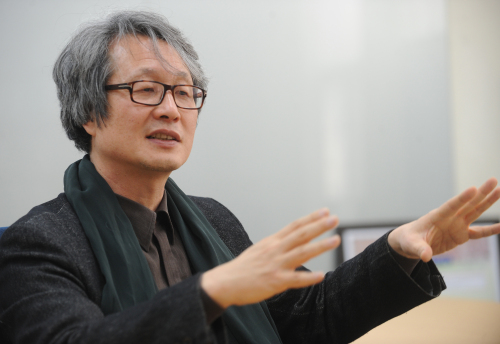For Song Inho, an architecture professor of the University of Seoul, the most propitious place in the capital is an area extending from the peak of Mount Inwang to its northern ridge.
On the summit of the mountain behind the presidential office, he can get a clear aerial view of the ancient fortress wall that encircles Seoul.
In the fortress wall, he also sees a thick layer of the 600-year history of the capital.
Fascinated by the magnificent landscape, he wants to share the beauty of the cultural heritage of Seoul with the international community and safeguard it.
Song, director of the Institute of Seoul Studies, and his research team have endeavored to gain UNESCO recognition for the Seoul Fortress Wall.
They seek to place it on the tentative list of World Heritage sites in June then win final designation in 2015.
“We are making efforts to rediscover outstanding value to humanity in the fortress wall so that the international community will recognize and also be convinced that the world should strive to preserve it,” Song said in a recent interview with The Korea Herald.
As part of the efforts, the institute on Wednesday held the first academic seminar on how to shed new light on the fortress’ value.
“Seoul Fortress Wall is distinct in shape and position in that it was built on hills. The beauty of its curve along mountain ridges is rare and unique, compared with well-known ancient city fortresses built on plains in China, such as geometrical Xian Fortress and Pingyao Fortress Wall,” Song noted.
He pointed out that Seoul Fortress Wall is located under an ancient geographical philosophy of Korea.
“Our ancestors believed in the existence of power in the geographical features of our land under the theory of feng shui, which studies harmony of objects with nature. They valued the links between mountains more than their height, and wrote a book about them in 1820. In accordance with feng shui, they selected the best site and shape of the wall to surround and protect the capital,” Song said.
 |
Song Inho, architecture professor of the University of Seoul and director of the Institute of Seoul Studies, speaks about Seoul Fortress Wall and projects of the institute. (Lee Sang-sub/The Korea Herald) |
The 18.7-kilometer-long wall guarded the royal seat of the Joseon Dynasty for more than 500 years from 1396 to 1910, the longest period for an existing fortress in the world.
It withstood numerous invasions, survived the Japanese colonial rule and lasted through the Korean War.
“Every part of Seoul Fortress Wall is a witness to over 500 years of history,” he said.
It is not just history that lives on. The devotion of people who built the wall is also remembered.
“Some of the names of the people who constructed the fortress wall remain on parts of it near the now-defunct Dongdaemun Stadium,” Song said.
The Seoul Metropolitan Government has undertaken a project to restore the wall in its entirety by 2014.
“Remembering the devotion and efforts of these people helps as the city and experts continue the restoration project.”
Tracing origin of Seoul
The Institute of Seoul Studies has researched the origin and history of places in the city since it was founded in 1993 to mark the city’s 600th anniversary as the capital of the nation.
“The city as we see now is full of modern skyscrapers, but if you look into it, you see historical layers, an accumulation of the history and lives of its people,” Song said.
“We regard the southern district of Gangnam as one of the most modern and busiest places in Seoul, but it is also a historic site, a home to royal tomb Seonjeongneung and Bongeun Buddhist Temple. The ISS sheds new light on modern spots and people’s lives, and studies what used to stand at high-rise places, what life was like back then,” he said.
He explained what it means to track the origin of places.
“If we have a better understanding of history of the place where we live right now, our lives will be richer and more creative,” he said.
The studies of the institute cover not only history and geography but also transportation, and environments. Its research results have laid the groundwork for city policies such as restoring and protecting historical sites.
As a professional architect, Song has contributed to preserving the traditional housing bloc, dubbed Bukchon hanok village, from urban development.
Its pioneering studies on cities and places have inspired not only local cities but also foreign cities like Beijing to create similar institutes.
It is expanding perspective of its Seoul studies to the East Asian level.
One of its long-term projects is research of the capital in comparison with other major cities in East Asia, including Beijing, Tokyo and Hanoi.
“In the future, it’s going to be about competition between cities. I think the new research project will be helpful to an increasingly city-centered world,” Song stressed.
By Lee Woo-young (
wylee@heraldcorp.com)







![[Weekender] Korea's traditional sauce culture gains global recognition](http://res.heraldm.com/phpwas/restmb_idxmake.php?idx=644&simg=/content/image/2024/11/21/20241121050153_0.jpg)
